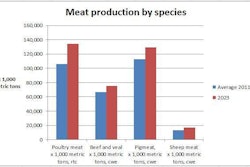The Biomin World Nutrition Forum, held in Munich in mid-October 2014, provided attendees with a broad range of ideas and research focused on sustainable production now and in the future. While much of the sustainability discussion focused on environmental concerns – responsible intensification, climate change, etc. – the secondary message was how stewardship is also achieved through animal health and welfare.
Biomin defines the three pillars of sustainability as: economic, environmental and social.
In this vein, Biomin has identified gut performance and mycotoxin management its two primary areas of opportunity moving forward. Improvements in both of these areas promote sustainable production, and it all begins with the health of the animal. Biomin recognizes healthy livestock is a key component of animal welfare; responsible animal management has positive impacts on the environment; healthy animals ensure the producer’s productivity and profitability; and it allows the producer to supply reasonably priced proteins to the consumer.
Poultry to rise to the top
The wide scope of plenary sessions was also narrowed to discussions specifically focused on the four main species: poultry, ruminants, aquaculture and swine. During the recap of these sessions, the consensus among the event’s speaker was that the poultry sector will come out on top as the “winning” protein of the future.
According to speaker Marty Matlock, executive director of the University of Arkansas’ office for sustainability, global meat production is expected to more than double by 2050, a feat that will need to be achieved with the same about of inputs as are being used today.
In terms of which protein will rise to the rank of “most consumed,” the tastes of both consumers in well-developed and emerging markets will likely lean in favor of poultry, with sources suggesting poultry consumption will grow by more than 120 percent by 2050.
Beyond the growth the industry has already experienced, the outlook for additional advancement in the areas of genetics, production and nutrition position the global poultry industry to maximize its margins and increase its volumes.
“[The world] needs all the meats and eggs, but poultry has its advantages,” says Tyson Foods’ senior nutritionist, Phillip Smith, focused his talk on how sustainability relates to the poultry industry.















